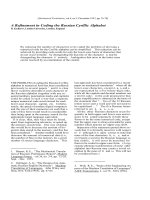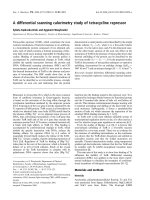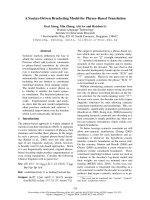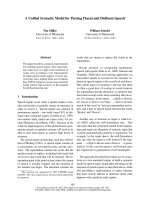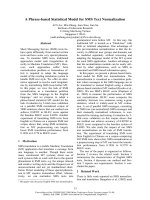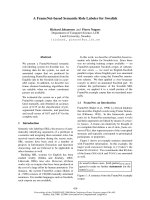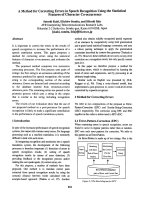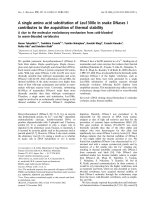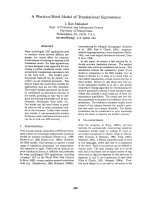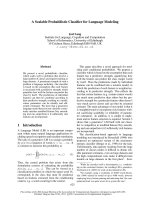Báo cáo khoa học: "A TAG-based noisy channel model of speech repairs" pdf
Bạn đang xem bản rút gọn của tài liệu. Xem và tải ngay bản đầy đủ của tài liệu tại đây (104.77 KB, 8 trang )
A TAG-based noisy channel model of speech repairs
Mark Johnson
Brown University
Providence, RI 02912
Eugene Charniak
Brown University
Providence, RI 02912
Abstract
This paper describes a noisy channel model of
speech repairs, which can identify and correct
repairs in speech transcripts. A syntactic parser
is used as the source model, and a novel type
of TAG-based transducer is the channel model.
The use of TAG is motivated by the intuition
that the reparandum is a “rough copy” of the
repair. The model is trained and tested on the
Switchboard disfluency-annotated corpus.
1 Introduction
Most spontaneous speech contains disfluencies
such as partial words, filled pauses (e.g., “uh”,
“um”, “huh”), explicit editing terms (e.g., “I
mean”), parenthetical asides and repairs. Of
these repairs pose particularly difficult problems
for parsing and related NLP tasks. This paper
presents an explicit generative model of speech
repairs and shows how it can eliminate this kind
of disfluency.
While speech repairs have been studied by
psycholinguists for some time, as far as we know
this is the first time a probabilistic model of
speech repairs based on a model of syntactic
structure has been described in the literature.
Probabilistic models have the advantage over
other kinds of models that they can in principle
be integrated with other probabilistic models to
produce a combined model that uses all avail-
able evidence to select the globally optimal anal-
ysis. Shriberg and Stolcke (1998) studied the lo-
cation and distribution of repairs in the Switch-
board corpus, but did not propose an actual
model of repairs. Heeman and Allen (1999) de-
scribe a noisy channel model of speech repairs,
but leave “extending the model to incorporate
higher level syntactic . . .processing” to future
work. The previous work most closely related
to the current work is Charniak and Johnson
(2001), who used a boosted decision stub classi-
fier to classify words as edited or not on a word
by word basis, but do not identify or assign a
probability to a repair as a whole.
There are two innovations in this paper.
First, we demonstrate that using a syntactic
parser-based language model Charniak (2001)
instead of bi/trigram language models signifi-
cantly improves the accuracy of repair detection
and correction. Second, we show how Tree Ad-
joining Grammars (TAGs) can be used to pro-
vide a precise formal description and probabilis-
tic model of the crossed dependencies occurring
in speech repairs.
The rest of this paper is structured as fol-
lows. The next section describes the noisy chan-
nel model of speech repairs and the section af-
ter that explains how it can be applied to de-
tect and repair speech repairs. Section 4 evalu-
ates this model on the Penn 3 disfluency-tagged
Switchboard corpus, and section 5 concludes
and discusses future work.
2 A noisy channel model of repairs
We follow Shriberg (1994) and most other work
on speech repairs by dividing a repair into three
parts: the reparandum (the material repaired),
the interregnum that is typically either empty
or consists of a filler, and the repair. Figure 1
shows these three parts for a typical repair.
Most current probabilistic language models
are based on HMMs or PCFGs, which induce
linear or tree-structured dependencies between
words. The relationship between reparandum
and repair seems to be quite different: the
repair is a “rough copy” of the reparandum,
often incorporating the same or very similar
words in roughly the same word order. That
is, they seem to involve “crossed” dependen-
cies between the reparandum and the repair,
shown in Figure 1. Languages with an un-
bounded number of crossed dependencies can-
not be described by a context-free or finite-
state grammar, and crossed dependencies like
these have been used to argue natural languages
. . . a flight to Boston,
Reparandum
uh, I mean,
Interregnum
to Denver
Repair
on Friday . . .
Figure 1: The structure of a typical repair, with crossing dependencies between reparandum and
repair.
I mean
uh
a flight to Boston
to Denver on Friday
Figure 2: The “helical” dependency structure induced by the generative model of speech repairs
for the repair depicted in Figure 1.
are not context-free Shieber (1985). Mildly
context-sensitive grammars, such as Tree Ad-
joining Grammars (TAGs) and Combinatory
Categorial Grammars, can describe such cross-
ing dependencies, and that is why TAGs are
used here.
Figure 2 shows the combined model’s de-
pendency structure for the repair of Figure 1.
Interestingly, if we trace the temporal word
string through this dependency structure, align-
ing words next to the words they are dependent
on, we obtain a “helical” type of structure famil-
iar from genome models, and in fact TAGs are
being used to model genomes for very similar
reasons.
The noisy channel model described here in-
volves two components. A language model de-
fines a probability distribution P(X) over the
source sentences X, which do not contain re-
pairs. The channel model defines a conditional
probability distribution P(Y |X) of surface sen-
tences Y , which may contain repairs, given
source sentences. In the work reported here,
X is a word string and Y is a speech tran-
scription not containing punctuation or partial
words. We use two language models here: a
bigram language model, which is used in the
search process, and a syntactic parser-based lan-
guage model Charniak (2001), which is used
to rescore a set of the most likely analysis ob-
tained using the bigram model. Because the
language model is responsible for generating the
well-formed sentence X, it is reasonable to ex-
pect that a language model that can model more
global properties of sentences will lead to bet-
ter performance, and the results presented here
show that this is the case. The channel model is
a stochastic TAG-based transducer; it is respon-
sible for generating the repairs in the transcript
Y , and it uses the ability of TAGs to straight-
forwardly model crossed dependencies.
2.1 Informal description
Given an observed sentence Y we wish to find
the most likely source sentence
X, where:
X = argmax
X
P(X|Y ) = argmax
X
P(Y |X)P(Y ).
This is the same general setup that is used
in statistical speech recognition and machine
translation, and in these applications syntax-
based language models P(Y ) yield state-of-the-
art performance, so we use one such model here.
The channel model P(Y |X) generates sen-
tences Y given a source X. A repair can po-
tentially begin before any word of X. When a
repair has begun, the channel model incremen-
tally processes the succeeding words from the
start of the repair. Before each succeeding word
either the repair can end or else a sequence of
words can be inserted in the reparandum. At
the end of each repair, a (possibly null) inter-
regnum is appended to the reparandum.
The intuition motivating the channel model
design is that the words inserted into the
reparandum are very closely related those in the
repair. Indeed, in our training data over 60% of
the words in the reparandum are exact copies of
words in the repair; this similarity is strong evi-
dence of a repair. The channel model is designed
so that exact copy reparandum words will have
high probability.
We assume that X is a substring of Y , i.e.,
that the source sentence can be obtained by
deleting words from Y , so for a fixed observed
sentence there are only a finite number of pos-
sible source sentences. However, the number of
source sentences grows exponentially with the
length of Y , so exhaustive search is probably
infeasible.
TAGs provide a systematic way of formaliz-
ing the channel model, and their polynomial-
time dynamic programming parsing algorithms
can be used to search for likely repairs, at least
when used with simple language models like a
bigram language model. In this paper we first
identify the 20 most likely analysis of each sen-
tence using the TAG channel model together
with a bigram language model. Then each of
these analysis is rescored using the TAG chan-
nel model and a syntactic parser based language
model.
The TAG channel model’s analysis do not re-
flect the syntactic structure of the sentence be-
ing analyzed; instead they encode the crossed
dependencies of the speech repairs. If we want
to use TAG dynamic programming algorithms
to efficiently search for repairs, it is necessary
that the intersection (in language terms) of the
TAG channel model and the language model it-
self be describable by a TAG. One way to guar-
antee this is to use a finite state language model;
this motivates our use of a bigram language
model.
On the other hand, it seems desirable to use a
language model that is sensitive to more global
properties of the sentence, and we do this by
reranking the initial analysis, replacing the bi-
gram language model with a syntactic parser
based model. We do not need to intersect this
parser based language model with our TAG
channel model since we evaluate each analysis
separately.
2.2 The TAG channel model
The TAG channel model defines a stochastic
mapping of source sentences X into observed
sentences Y . There are several ways to de-
fine transducers using TAGs such as Shieber
and Schabes (1990), but the following simple
method, inspired by finite-state transducers,
suffices for the application here. The TAG de-
fines a language whose vocabulary is the set of
pairs (Σ∪{∅})×(Σ∪{∅}), where Σ is the vocab-
ulary of the observed sentences Y . A string Z
in this language can be interpreted as a pair
of strings (Y, X), where Y is the concatena-
tion of the projection of the first components
of Z and X is the concatenation of the projec-
tion of the second components. For example,
the string Z = a:a flight:flight to:∅ Boston:∅
uh:∅ I:∅ mean:∅ to:to Denver:Denver on:on Fri-
day:Friday corresponds to the observed string
Y = a flight to Boston uh I mean to Denver
on Friday and the source string X = a flight to
Denver on Friday.
Figure 3 shows the TAG rules used to gen-
erate this example. The nonterminals in this
grammar are of the form N
w
x
, R
w
y
:w
x
and I,
where w
x
is a word appearing in the source
string and w
y
is a word appearing in the ob-
served string. Informally, the N
w
x
nonterminals
indicate that the preceding word w
x
was an-
alyzed as not being part of a repair, while the
R
w
y
:w
x
that the preceding words w
y
and w
x
were
part of a repair. The nonterminal I generates
words in the interregnum of a repair. Encoding
the preceding words in the TAGs nonterminals
permits the channel model to be sensitive to
lexical properties of the preceding words. The
start symbol is N
$
, where ‘$’ is a distinguished
symbol used to indicate the beginning and end
of sentences.
2.3 Estimating the repair channel
model from data
The model is trained from the disfluency and
POS tagged Switchboard corpus on the LDC
Penn tree bank III CD-ROM (specifically, the
files under dysfl/dps/swbd). This version of the
corpus annotates the beginning and ending po-
sitions of repairs as well as fillers, editing terms,
asides, etc., which might serve as the interreg-
num in a repair. The corpus also includes punc-
tuation and partial words, which are ignored in
both training and evaluation here since we felt
that in realistic applications these would not be
available in speech recognizer output. The tran-
script of the example of Figure 1 would look
something like the following:
a/DT flight/NN [to/IN Boston/NNP +
{F uh/UH} {E I/PRP mean/VBP} to/IN
Denver/NNP] on/IN Friday/NNP
In this transcription the repair is the string
from the opening bracket “[” to the interrup-
tion point “+”; the interregnum is the sequence
of braced strings following the interregnum, and
the repair is the string that begins at the end of
the interregnum and ends at the closing bracket
“]”. The interregnum consists of the braced
(α
1
)
N
want
a:a N
a ↓
1 − P
n
(repair|a)
(α
2
)
N
a
flight:flight R
flight:flight
I
↓
P
n
(repair|flight)
(α
3
)
N
Denver
on:on N
on ↓
1 − P
n
(repair|on)
(α
5
)
I
uh I
I mean
P
i
(uh I mean)
(β
1
)
R
flight:flight
to:∅ R
to:to
R
flight:flight
to:to
P
r
(copy|flight, flight)
(β
2
)
R
to:to
Boston:∅ R
Boston:Denver
R
to:to
Denver:Denver
P
r
(subst|to, to)P
r
(Boston|subst, to, Denver)
(β
3
)
R
Boston:Denver
R
Boston:Denver
N
Denver ↓
P
r
(nonrep|Boston, Denver)
(β
4
)
R
Boston,Denver
R
Boston,tomorrow
R
Boston,Denver
tomorrow:tomorrow
P
r
(del|Boston, Denver)
(β
5
)
R
Boston,Denver
tomorrow:∅ R
tomorrow,Denver
R
Boston,Denver
P
r
(ins|Boston, Denver)
P
r
(tomorrow|ins, Boston, Denver)
. . .
α
1
α
2
α
5
β
1
β
2
β
3
α
3
α
4
. . .
N
want
a:a N
a
flight:flight R
flight:flight
to:∅ R
to:to
Boston:∅ R
Boston:Denver
R
Boston:Denver
R
to:to
R
flight:flight
I
uh:∅ I
I:∅ mean:∅
to:to
Denver:Denver
N
Denver
on:on N
on
Friday:Friday N
Friday
. . .
Figure 3: The TAG rules used to generate the example shown in Figure 1 and their respective
weights, and the corresponding derivation and derived trees.
expressions immediately following the interrup-
tion point. We used the disfluency tagged
version of the corpus for training rather than
the parsed version because the parsed version
does not mark the interregnum, but we need
this information for training our repair channel
model. Testing was performed using data from
the parsed version since this data is cleaner, and
it enables a direct comparison with earlier work.
We followed Charniak and Johnson (2001) and
split the corpus into main training data, held-
out training data and test data as follows: main
training consisted of all sw[23]*.dps files, held-
out training consisted of all sw4[5-9]*.dps files
and test consisted of all sw4[0-1]*.mrg files.
We now describe how the weights on the TAG
productions described in subsection 2.2 are es-
timated from this training data. In order to es-
timate these weights we need to know the TAG
derivation of each sentence in the training data.
In order to uniquely determine this we need the
not just the locations of each reparandum, in-
terregnum and repair (which are annotated in
the corpus) but also the crossing dependencies
between the reparandum and repair words, as
indicated in Figure 1.
We obtain these by aligning the reparan-
dum and repair strings of each repair using
a minimum-edit distance string aligner with
the following alignment costs: aligning identi-
cal words costs 0, aligning words with the same
POS tag costs 2, an insertion or a deletion costs
4, aligning words with POS tags that begin with
the same letter costs 5, and an arbitrary sub-
stitution costs 7. These costs were chosen so
that a substitution will be selected over an in-
sertion followed by a deletion, and the lower
cost for substitutions involving POS tags be-
ginning with the same letter is a rough and
easy way of establishing a preference for align-
ing words whose POS tags come from the same
broad class, e.g., it results in aligning singular
and plural nouns, present and past participles,
etc. While we did not evaluate the quality of
the alignments since they are not in themselves
the object of this exercise, they seem to be fairly
good.
From our training data we estimate a number
of conditional probability distributions. These
estimated probability distributions are the lin-
ear interpolation of the corresponding empirical
distributions from the main sub-corpus using
various subsets of conditioning variables (e.g.,
bigram models are mixed with unigram models,
etc.) using Chen’s bucketing scheme Chen and
Goodman (1998). As is commonly done in lan-
guage modelling, the interpolation coefficients
are determined by maximizing the likelihood of
the held out data counts using EM. Special care
was taken to ensure that all distributions over
words ranged over (and assigned non-zero prob-
ability to) every word that occurred in the train-
ing corpora; this turns out to be important as
the size of the training data for the different
distributions varies greatly.
The first distribution is defined over the
words in source sentences (i.e., that do
not contain reparandums or interregnums).
P
n
(repair|W ) is the probability of a repair be-
ginning after a word W in the source sentence
X; it is estimated from the training sentences
with reparandums and interregnums removed.
Here and in what follows, W ranges over Σ ∪
{$}, where ‘$’ is a distinguished beginning-of-
sentence marker. For example, P
n
(repair|flight)
is the probability of a repair beginning after the
word flight. Note that repairs are relatively rare;
in our training data P
n
(repair) ≈ 0.02, which is
a fairly strong bias against repairs.
The other distributions are defined over
aligned reparandum/repair strings, and are es-
timated from the aligned repairs extracted from
the training data. In training we ignored
all overlapping repairs (i.e., cases where the
reparandum of one repair is the repair of an-
other). (Naturally, in testing we have no such
freedom.) We analyze each repair as consisting
of n aligned word pairs (we describe the inter-
regnum model later). M
i
is the ith reparan-
dum word and R
i
is the corresponding repair
word, so both of these range over Σ ∪ {∅}.
We define M
0
and R
0
to be source sentence
word that preceded the repair (which is ‘$’ if
the repair begins at the beginning of a sen-
tence). We define M
i
and R
i
to be the last non-∅
reparandum and repair words respectively, i.e.,
M
i
= M
i
if M
i
= ∅ and M
i
= M
i−1
oth-
erwise. Finally, T
i
, i = 1 . . . n + 1, which in-
dicates the type of repair that occurs at posi-
tion i, ranges over {copy, subst, ins, del, nonrep},
where T
n+1
= nonrep (indicating that the re-
pair has ended), and for i = 1 . . . n, T
i
= copy if
M
i
= R
i
, T
i
= ins if R
i
= ∅, T
i
= del if M
i
= ∅
and T
i
= subst otherwise.
The distributions we estimate from the
aligned repair data are the following.
P
r
(T
i
|M
i−1
, R
i−1
) is the probability of see-
ing repair type T
i
following the reparan-
dum word M
i−1
and repair word R
i−1
; e.g.,
P
r
(nonrep|Boston, Denver) is the probability of
the repair ending when Boston is the last
reparandum word and Denver is the last repair
word.
P
r
(M
i
|T
i
= ins, M
i−1
, R
i
) is the probability
that M
i
is the word that is inserted into the
reparandum (i.e., R
i
= ∅) given that some word
is substituted, and that the preceding reparan-
dum and repair words are M
i−1
and R
i
. For ex-
ample P
r
(tomorrow|ins, Boston, Denver) is the
probability that the word tomorrow is inserted
into the reparandum after the words Boston and
Denver, given that some word is inserted.
P
r
(M
i
|T
i
= subst, M
i−1
, R
i
) is the prob-
ability that M
i
is the word that is substi-
tuted in the reparandum for R
i
, given that
some word is substituted. For example,
P
r
(Boston|subst, to, Denver) is the probability
that Boston is substituted for Denver, given
that some word is substituted.
Finally, we also estimated a probability dis-
tribution P
i
(W ) over interregnum strings as fol-
lows. Our training corpus annotates what we
call interregnum expressions, such as uh and
I mean. We estimated a simple unigram distri-
bution over all of the interregnum expressions
observed in our training corpus, and also ex-
tracted the empirical distribution of the num-
ber of interregnum expressions in each repair.
Interregnums are generated as follows. First,
the number k of interregnum expressions is cho-
sen using the empirical distribution. Then k
interregnum expressions are independently gen-
erated from the unigram distribution of inter-
regnum expressions, and appended to yield the
interregnum string W .
The weighted TAG that constitutes the chan-
nel model is straight forward to define us-
ing these conditional probability distributions.
Note that the language model generates the
source string X. Thus the weights of the TAG
rules condition on the words in X, but do not
generate them.
There are three different schema defining the
initial trees of the TAG. These correspond to
analyzing a source word as not beginning a re-
pair (e.g., α
1
and α
3
in Figure 3), analyzing a
source word as beginning a repair (e.g., α
2
), and
generating an interregnum (e.g., α
5
).
Auxiliary trees generate the paired reparan-
dum/repair words of a repair. There are five dif-
ferent schema defining the auxiliary trees corre-
sponding to the five different values that T
i
can
take. Note that the nonterminal R
m,r
expanded
by the auxiliary trees is annotated with the last
reparandum and repair words M
i−1
and R
i−1
respectively, which makes it possible to condi-
tion the rule’s weight on these words.
Auxiliary trees of the form (β
1
) gener-
ate reparandum words that are copies of
the corresponding repair words; the weight
on such trees is P
r
(copy|M
i−1
, R
i−1
). Trees
of the form (β
2
) substitute a reparan-
dum word for a repair word; their weight
is P
r
(subst|M
i−1
, R
i−1
)P
r
(M
i
|subst, M
i−1
, R
i
).
Trees of the form (β
3
) end a repair; their weight
is P
r
(nonrep|, M
i−1
, R
i−1
). Auxiliary trees of
the form (β
3
) end a repair; they are weighted
P
r
(nonrep|M
i−1
, R
i−1
). Auxiliary trees of the
form (β
4
) permit the repair word R
i−1
to be
deleted in the reparandum; the weight of such
a tree is P
r
(del|M
i−1
, R
i−1
). Finally, auxiliary
trees of the form (β
5
) generate a reparandum
word M
i
is inserted; the weight of such a tree is
P
r
(ins|M
i−1
, R
i−1
)P
r
(M
i
|ins, M
i−1
, R
i−1
).
3 Detecting and repairing speech
repairs
The TAG just described is not probabilistic;
informally, it does not include the probability
costs for generating the source words. How-
ever, it is easy to modify the TAG so it does
include a bigram model that does generate the
source words, since each nonterminal encodes
the preceding source word. That is, we multi-
ply the weights of each TAG production given
earlier that introduces a source word R
i
by
P
n
(R
i
|R
i−1
). The resulting stochastic TAG is
in fact exactly the intersection of the channel
model TAG with a bigram language model.
The standard n
5
bottom-up dynamic pro-
gramming parsing algorithm can be used with
this stochastic TAG. Each different parse of
the observed string Y with this grammar corre-
sponds to a way of analyzing Y in terms of a hy-
pothetical underlying sentence X and a number
of different repairs. In our experiments below
we extract the 20 most likely parses for each sen-
tence. Since the weighted grammar just given
does not generate the source string X, the score
of the parse using the weighted TAG is P(Y |X).
This score multiplied by the probability P(X)
of the source string using the syntactic parser
based language model, is our best estimate of
the probability of an analysis.
However, there is one additional complica-
tion that makes a marked improvement to
the model’s performance. Recall that we use
the standard bottom-up dynamic programming
TAG parsing algorithm to search for candidate
parses. This algorithm has n
5
running time,
where n is the length of the string. Even though
our sentences are often long, it is extremely un-
likely that any repair will be longer than, say,
12 words. So to increase processing speed we
only compute analyses for strings of length 12
or less. For every such substring that can be an-
alyzed as a repair we calculate the repair odds,
i.e., the probability of generating this substring
as a repair divided by the probability of gener-
ating this substring via the non-repair rules, or
equivalently, the odds that this substring consti-
tutes a repair. The substrings with high repair
odds are likely to be repairs.
This more local approach has a number of
advantages over computing a global analysis.
First, as just noted it is much more efficient
to compute these partial analyses rather than
to compute global analyses of the entire sen-
tence. Second, there are rare cases in which
the same substring functions as both repair and
reparandum (i.e., the repair string is itself re-
paired again). A single global analysis would
not be able to capture this (since the TAG chan-
nel model does not permit the same substring
to be both a reparandum and a repair), but
we combine these overlapping repair substring
analyses in a post-processing operation to yield
an analysis of the whole sentence. (We do in-
sist that the reparandum and interregnum of a
repair do not overlap with those of any other
repairs in the same analysis).
4 Evaluation
This section describes how we evaluate our noisy
model. As mentioned earlier, following Char-
niak and Johnson (2001) our test data consisted
of all Penn III Switchboard tree-bank sw4[0-
1]*.mrg files. However, our test data differs
from theirs in that in this test we deleted all
partial words and punctuation from the data,
as this results in a more realistic test situation.
Since the immediate goal of this work is to
produce a program that identifies the words of a
sentence that belong to the reparandum of a re-
pair construction (to a first approximation these
words can be ignored in later processing), our
evaluation focuses on the model’s performance
in recovering the words in a reparandum. That
is, the model is used to classify each word in the
sentence as belonging to a reparandum or not,
and all other additional structure produced by
the model is ignored.
We measure model performance using stan-
dard precision p, recall r and f-score f, mea-
sures. If n
c
is the number of reparandum words
the model correctly classified, n
t
is the number
of true reparandum words given by the manual
annotations and n
m
is the number of words the
model predicts to be reparandum words, then
the precision is n
c
/n
m
, recall is n
c
/n
t
, and f is
2pr/(p + r).
For comparison we include the results of run-
ning the word-by-word classifier described in
Charniak and Johnson (2001), but where par-
tial words and punctuation have been removed
from the training and test data. We also pro-
vide results for our noisy channel model using
a bigram language model and a second trigram
model where the twenty most likely analyses are
rescored. Finally we show the results using the
parser language model.
CJ01
Bigram Trigram Parser
Precision 0.951 0.776 0.774 0.820
Recall 0.631 0.736 0.763 0.778
F-score 0.759 0.756 0.768 0.797
The noisy channel model using a bigram lan-
guage model does a slightly worse job at identi-
fying reparandum and interregnum words than
the classifier proposed in Charniak and Johnson
(2001). Replacing the bigram language model
with a trigram model helps slightly, and parser-
based language model results in a significant
performance improvement over all of the oth-
ers.
5 Conclusion and further work
This paper has proposed a novel noisy chan-
nel model of speech repairs and has used it to
identify reparandum words. One of the advan-
tages of probabilistic models is that they can be
integrated with other probabilistic models in a
principled way, and it would be interesting to
investigate how to integrate this kind of model
of speech repairs with probabilistic speech rec-
ognizers.
There are other kinds of joint models of
reparandum and repair that may produce a bet-
ter reparandum detection system. We have
experimented with versions of the models de-
scribed above based on POS bi-tag dependen-
cies rather than word bigram dependencies, but
with results very close to those presented here.
Still, more sophisticated models may yield bet-
ter performance.
It would also be interesting to combine this
probabilistic model of speech repairs with the
word classifier approach of Charniak and John-
son (2001). That approach may do so well be-
cause many speech repairs are very short, in-
volving only one or two words Shriberg and
Stolcke (1998), so the reparandum, interregnum
and repair are all contained in the surround-
ing word window used as features by the classi-
fier. On the other hand, the probabilistic model
of repairs explored here seems to be most suc-
cessful in identifying long repairs in which the
reparandum and repair are similar enough to be
unlikely to have been generated independently.
Since the two approaches seem to have different
strengths, a combined model may outperform
both of them.
References
Eugene Charniak and Mark Johnson. 2001.
Edit detection and parsing for transcribed
speech. In Proceedings of the 2nd Meeting
of the North American Chapter of the Asso-
ciation for Computational Linguistics, pages
118–126. The Association for Computational
Linguistics.
Eugene Charniak. 2001. Immediate-head pars-
ing for language models. In Proceedings of the
39th Annual Meeting of the Association for
Computational Linguistics. The Association
for Computational Linguistics.
Stanley F. Chen and Joshua Goodman. 1998.
An empirical study of smoothing techniques
for language modeling. Technical Report TR-
10-98, Center for Research in Computing
Technology, Harvard University.
Peter A. Heeman and James F. Allen. 1999.
Speech repairs, intonational phrases, and dis-
course markers: Modeling speaker’s utter-
ances in spoken dialogue. Computational
Linguistics, 25(4):527–571.
Stuart M. Shieber and Yves Schabes. 1990.
Synchronous tree-adjoining grammars. In
Proceedings of the 13th International Confer-
ence on Computational Linguistics (COLING
1990), pages 253–258.
Stuart M. Shieber. 1985. Evidence against the
Context-Freeness of natural language. Lin-
guistics and Philosophy, 8(3):333–344.
Elizabeth Shriberg and Andreas Stolcke. 1998.
How far do speakers back up in repairs? a
quantitative model. In Proceedings of the In-
ternational Conference on Spoken Language
Processing, volume 5, pages 2183–2186, Syd-
ney, Australia.
Elizabeth Shriberg. 1994. Preliminaries to a
Theory of Speech Disfluencies. Ph.D. thesis,
University of California, Berkeley.
